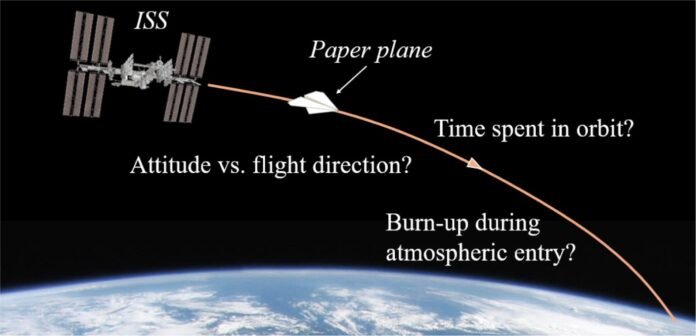Sometimes there are profound questions in life that must be answered, like “What is the meaning of existence?”, “Are we alone in the universe?” or “What happens if you throw a paper airplane from the International Space Station?” Luckily, that third one has finally been answered, because of course someone would eventually. A new paper from Maximilien Berthet and Kojiro Suzuki from the University of Tokyo looks at “the dynamics of an origami space plane during Earth atmospheric reentry” – in other words, what happens when you throw a paper plane out of the ISS.
First, let’s go over some technical ideas that are necessary to understanding this seemingly simple concept. Origami literally means folded paper in Japanese, and in this case the authors decided to make their paper airplane out of a standard A4 sheet of white paper. The end result looks like something a 3rd grader would have made up to annoy their friend sitting in front of them in class, but with a lot more aerodynamic modeling.
Once the software model was made, it was time to put it to the test. The ISS orbits at around 400 km, so the authors decided to launch the plane from that height, and at a speed similar to that of the ISS itself – 7800 m/s. That speed might seem likely it would shred any plane made out of paper, but at 400 km altitude the atmosphere isn’t thick enough to do much damage…yet.
Obviously this question has been around for a long time – here’s a video from 5 years ago about what would happen in this scenario. Credit – Ridddle YouTube Channel
That’s actually the case for the majority of the descent back to the ground. From 400 km down to around 120 km altitude, the plane stays relatively stable, given the lack of air. However, the plane descends very quickly due to its low ballistic coefficient, which is a measure of how well it can overcome air resistance. With its low ballistic coefficient, the plane rapidly slow, descending to 120 km in about 3.5 days.
On the slip side, a low ballistic coefficient would mean that, once the plane entered the atmosphere it would actually have a lower terminal velocity than something like a cannonball. Unfortunately it never makes it that far, as, according to the simulations, at around 120 km altitude, the increased air density induces uncontrollable tumbling, essentially sending the plane into an uncontrollable flight path familiar to anyone who has ever made one of them.
But why stop at simulations when you have a PhD in Aerospace Engineering and can build a paper airplane for science? And why just build one when you can test one in a hyper-advanced wind tunnel on your university’s campus? The answer is you don’t stop – which is why the authors built an actual paper airplane model (admittedly with an aluminum tail) and put it into the Kashiwa Hypersonic and High Enthalpy Wind Tunnel at the University of Tokyo to see what kind of aerodynamic forces their paper airplane could withstand.
In the never-ending pursuit of content, of course other YouTubers would try to launch a paper airplane from space. Credit – Zealous YouTube Channel
They didn’t go easy on their experiments either. Their one-third model paper airplane was subjected to Mach 7 winds for 7 seconds, similar to the forces experienced during actual reentry. This, unsurprisingly, bent the nose of the paper airplane back, but to its credit it didn’t disintegrate – at least not in that amount of time. There was also noticeable evidence of charring on the nose and wing tips, indicating that, if the experiment had gone on longer, the paper plane would have burnt up.
Ultimately, proving that’s what would happen was one of the purposes of this experiment. There are plenty of mission architectures that could potentially use something similar to this paper airplane model – the LEAVES experiment for Venus exploration comes to mind, but there are also plenty of Earth observations that would benefit from a lightweight, stable platform to do their collecting from while burning up completely in the atmosphere at their end of life.
Mounting any such mission would require electronics and many other additions that would complicate the purity of testing a simple paper plane that a kid could have made it class. But sometimes science is as much about inspiration as it is about exploration, and the results in this paper provide a nice mix of both.
Learn More:
M. Berthet & K Suzuki – Study on the dynamics of an origami space plane during Earth atmospheric entry
UT – Paper Boomerang will be Tested on Space Station
UT – Floating LEAVES Could Characterize Venus’s Atmosphere
Wikipedia – Paper planes launched from space


